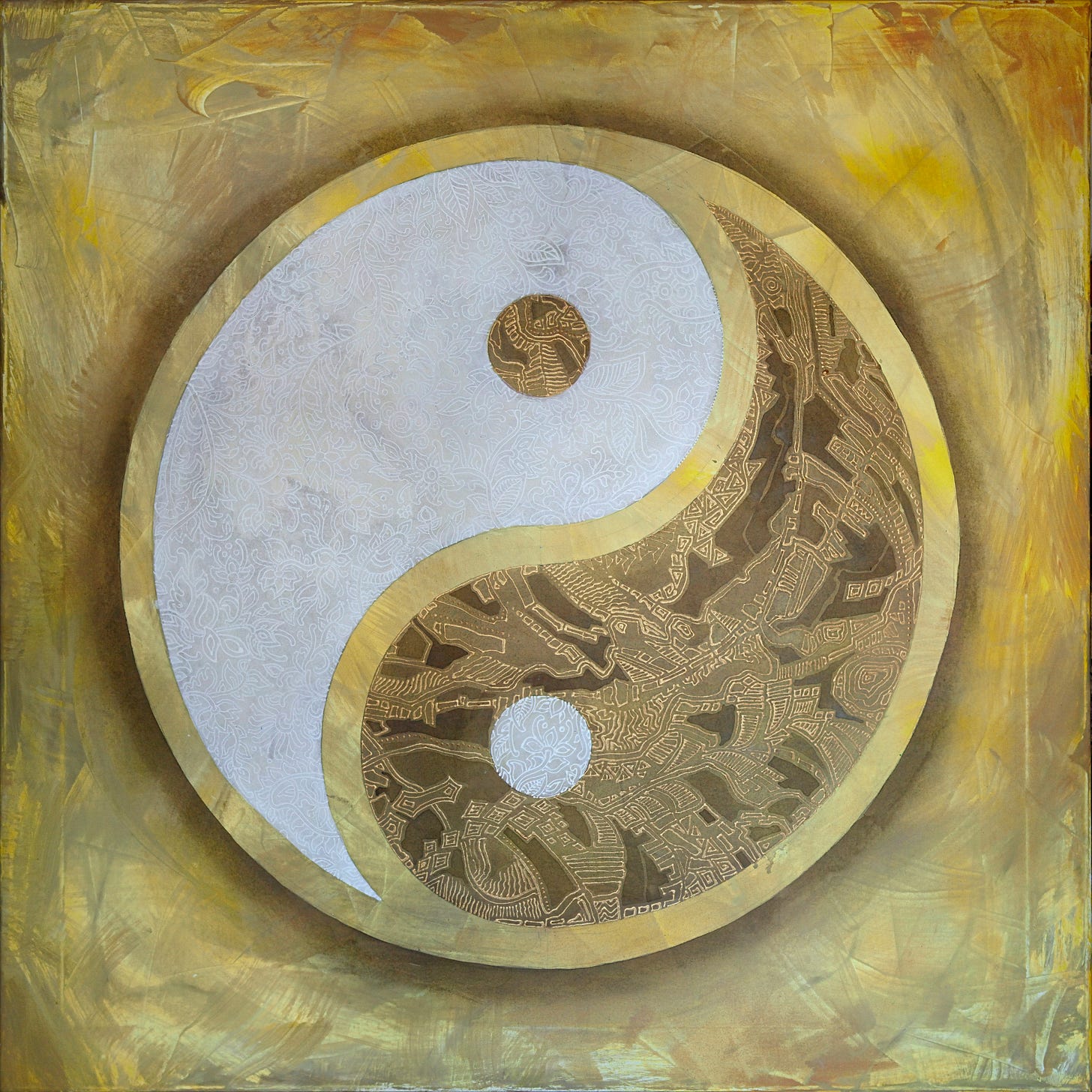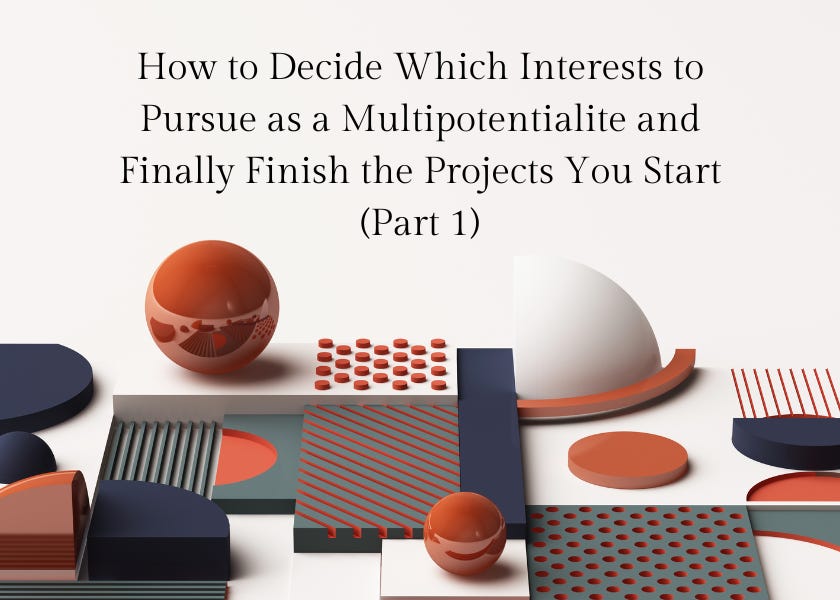How to Choose Which Interests to Pursue as a Multipotentialite and Finally Finish the Projects You Start (Part 1)
The False Dichotomy Between Focusing on One Thing and Not Focusing at all, What People Get Wrong About the Creative Process, and Why That Matters for Choosing Which Interests to Pursue
It’s a problem every multipotentialite has to deal with:
“I have so many interests, and I love them all! But I don’t have time for everything! So how do I choose which interests to pursue without feeling like I’m losing out?”
Believe me, I know that feeling.
If you ask people for advice on what to do here, they’ll typically recommend one of three things:
Focus on just one thing! Forget about everything else until that’s done.
Just refuse to choose! You can do it all if you really want.
Golden middle! Limit yourself to 3 or 4 focus projects.
The problem is that neither one of these strategies ever worked for me.
Here’s what happened when I tried to follow that advice:
If I tried to focus on one thing, I became unhappy after a while because I wasn’t honoring my need for variety.
If I tried to do it all, I spread myself too thin—and ended up not finishing any of the projects I started. I wasted a ton of time with nothing to show for it.
If I tried to limit myself to a few focus projects, I actually did finish some projects. But the problem at large remained. Because FOMO (Fear of Missing Out) is a real problem for me. Even authors who recommend this strategy admit that your 3 or 4 things will change over time. And for me, they typically changed before I finished most of what I started, because all that other stuff I was interested in seemed too seductive.
And we’re not even talking about deciding WHICH interests to pursue and develop!
Can you relate?
So what can be done here? How do you choose which interests to pursue, and how many at a time?
Well…
*Dons Morpheus sunglasses*
What if I told you that you’re asking the wrong questions?

Here’s the right question to ask:
What stage of the creative process am I in?
I’ll show you how this question will help you choose which interests to pursue without feeling like you’re missing out, and to actually finish the projects you start.
I split this article up into two parts to make it more digestible.
In the first part (the one you’re reading right now), I will talk about the creative process because it’s actually crucial for choosing which interests to pursue. You need to truly understand it before you even think about which interests to pursue. You’ll see why in part 2.
So make sure to subscribe to my Substack so you don’t miss that second part.
Alright, let’s jump in!
The false dichotomy between focusing on one thing and doing many things
It may look like focusing on one thing and not focusing at all are opposite ends of a spectrum.
Either-or.
Either you focus on one thing.
Or you don’t focus on anything at all.
Well, or you choose the middle ground—like focusing on 3 or 4 things at a time—and then you’re somewhere in the middle of the spectrum.
At first blush, it seems like those are the only choices you have.
And that’s true—but it’s not the whole truth.
If you change the perspective from which you look at a problem, the problem also changes, and you can see a new and different solution.
You see, the problem is that in the Western World, we have a very rigid, dualistic, and analytical way of thinking about decision-making and balance. If the options are A and B, then we believe we have to pick either A or B, and then that decision is done.
But in other cultures (for example, some South-East Asian cultures), people wouldn’t necessarily agree with this.
In these cultures, in which analytical thinking isn’t always the default mode of thinking, many people would argue that you have to take the context into consideration.
And that context changes with the flow of time.
As time goes by, your circumstances, needs, and goals change.
And so what you invest your time and energy in should change as well.
This is an idea that is very common in philosophies like Taoism, and is reflected in symbols like the yin yang.

Over the past few 20 years or so, it has also caught on in the West—for example, in the management and leadership literature, where academics and practitioners alike are noticing how useful this idea is for managing and leading organizations in our volatile, unpredictable, uncertain, and ambivalent modern world in which the context is constantly changing.1
You can apply the same idea to self-leadership and self-management!
I’ll show you how.
Here’s a graphic that I adapted from Tiago Forte’s book “Building a Second Brain”, and that illustrates what I mean.
It shows the creative process, by which I mean the process of creating anything:

The creative process starts with an idea. The more innovative or vague your idea, the less you’ll know what’s required to turn your idea to reality, or even what it would look like in reality.
Keep this idea in mind since it’s crucial for thinking about the interests you’ll pursue.
Because you usually don’t know what you need to go from idea to finished project, you need to keep your filters open and explore multiple things. You’ll be gathering information about building blocks, tools, and so on, and you develop more and more clarity about what it is you’re building and what it will look like in the end.
But at some point, you have to put your blinders on and close your filters. The more clarity you gain about what your finished project will look like, the more you have to focus. After a certain point, collecting more information will only lead to distraction—with the result that you won’t be able to complete your project.
So you’ll have to focus on that one thing for now, until it’s done.
Once you’re done with that project, you can take the blinders off again and start exploring and gathering information for the next thing you’ll build.
This is how the process of creation and innovation works, no matter what it is you’re creating.
Notice that the question here is not “Should I focus on one thing, on four things, or not focus at all?” Neither is it “What should I focus on?”
The question is: What stage of the creative process am I in?
So the answer to the question of what interests you should pursue and whether you should focus on one thing, several things, or not focus at all depends on your context—which stage of the creative process you’re currently in.
THAT is what most people get wrong about the creative process.
To create anything, you need a dynamic, floating balance between focus and variety that shifts over time, as your creative project takes shape.
It’s not either-or, it’s both-and!
Can you see how this idea is also reflected in the Yin-Yang symbol and its two intertwined halves?
All you need to know is if you’re currently exploring and gathering information about what you’ll build and how, or if you’re in the phase of actually building the thing already.
Once you know that, you can decide whether to focus, or keep the filter of your attention open…
…and whether to focus on one thing, refuse to choose, or something in between.
This is how you get beyond the false dichotomy between focus and variety, and actually produce tangible results for yourself!
“Okay,” I hear you say, “but how does this help me choose which interests to pursue when I’m just living my life, and not building anything in particular?”
Well…
*Dons Morpheus Sunglasses again*
What if I told you that you’re ALWAYS building something?
You’re always building the work of your life.
Or call it the piece of creative art that is your life, if you prefer.
You can’t do nothing, and whatever you’re doing becomes part of the picture that is your life.
You can’t avoid this-. The only question is how intentional you are about building this work of your life.
Polymaths, synthesizers, and all the other adventurers of life who are driven by their curiosity and their desire for learning are always working towards the work of their lives, just like anybody else.
The difference is that BECAUSE they are adventures of life who are driven by their curiosity and their desire to travel through uncharted territory, they often CAN’T know what they are building.
If that describes you, too, I have good news for you:
This process works even when you don’t know what it is you’re building!
It works on the micro-level of the individual project and on the macro-level of your life.
In my next article, I’ll talk about that macro-level—the work of your life.
Other ways I can help you: I offer life and career coaching for multipotentialites, polymaths, renaissance people, multipassionate creators, and basically all adventurers of life who don’t want to follow a beaten path through life, but create their own path. You can find more information on my website: https://newrenaissancecoaching.com/
P.S. If you enjoyed this post, please share it with your friends.
For example, see Smith, W. K., & Lewis, M. W. (2011). Toward a Theory of Paradox: A Dynamic equilibrium Model of Organizing. Academy of Management Review, 36(2), 381–403. https://doi.org/10.5465/amr.2009.0223; Smith, W. K., & Tushman, M. L. (2005). Managing Strategic Contradictions: A Top Management Model for Managing Innovation Streams. Organization Science, 16(5), 522–536. https://doi.org/10.1287/orsc.1050.0134; Zhang, Y., Waldman, D. A., Han, Y.-L., & Li, X.-B. (2015). Paradoxical Leader Behaviors in People Management: Antecedents and Consequences. Academy of Management Journal, 58(2), 538–566. https://doi.org/10.5465/amj.2012.0995



I discovered I am creating my own larger mythical journey and that my art, especially writing poetry, is directly co-creating it, especially when given to people I travel with or invite to.
I realized that when I sorted my seemingly unordered works into Campbell’s Hero’s Journey monomyth phases (per the good descriptions on wikipedia).
Are you writing your life into existence yet? Try it out.
https://panzerknacker.substack.com/p/here-you-are